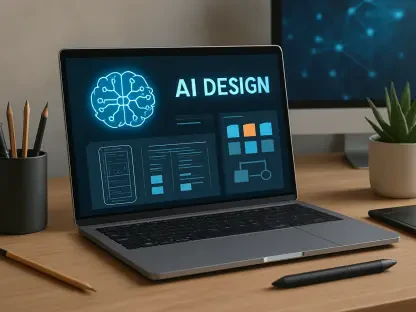The Current State of Cybersecurity in the AI Era
In an era where cyber threats evolve at an unprecedented pace, Artificial Intelligence (AI) stands as a critical pillar in fortifying digital defenses across industries, and as of 2025, the cybersecurity landscape is undergoing a seismic shift driven by AI and Machine Learning (ML) technologies. These advancements enable organizations to anticipate and counter sophisticated attacks with remarkable precision. No longer confined to supplementary roles, these tools are now central to endpoint security and network monitoring, providing real-time threat detection and autonomous response capabilities that outstrip traditional methods. This transformation reflects a broader recognition that static defenses are insufficient against dynamic, AI-enhanced threats like polymorphic malware and zero-day exploits.
The transition from reactive to proactive security measures marks a significant departure from past practices. Legacy systems, reliant on signature-based detection, often lag behind the speed and cunning of modern adversaries, leaving critical gaps in protection. In contrast, AI-driven solutions analyze vast datasets to identify behavioral anomalies, neutralize threats before they escalate, and adapt to new attack patterns without human intervention. Key segments such as endpoint security benefit from Next-Generation Endpoint Protection (NGEP), while network monitoring leverages AI to maintain vigilance across distributed environments. Frameworks like Zero Trust Architecture (ZTA), Secure Access Service Edge (SASE), and Extended Detection and Response (XDR) are becoming industry standards, embedding AI to ensure continuous verification and comprehensive visibility.
Market dynamics further illustrate AI’s pervasive influence, with leading players like SentinelOne, CrowdStrike, and Microsoft setting the pace through innovative platforms that integrate intelligent defense mechanisms. Competitive pressures are pushing vendors to consolidate security tools into unified systems, marginalizing those unable to adopt AI capabilities. Additionally, government mandates are amplifying this trend, with national cybersecurity strategies increasingly advocating for AI-enhanced frameworks like ZTA to safeguard critical infrastructure. This convergence of technology and policy underscores a pivotal moment where digital resilience hinges on the strategic deployment of intelligent solutions.
Emerging Trends and Innovations in AI-Driven Cybersecurity
Key Technological Advancements and Market Drivers
AI has emerged as the backbone of cybersecurity, powering tools that redefine how threats are detected and mitigated. Innovations like NGEP and behavioral analysis enable systems to spot subtle deviations in user or device activity, addressing vulnerabilities that evade conventional defenses. These advancements are crucial in countering an evolving threat landscape where adversaries wield AI to craft polymorphic malware and execute zero-day attacks with alarming efficiency. The ability of AI to learn from each interaction ensures that defenses remain agile, adapting to novel tactics in real time.
Beyond specific tools, broader market drivers are fueling the adoption of autonomous security solutions. The rise of hybrid work models and cloud computing has expanded attack surfaces, compelling organizations to seek integrated platforms that operate without constant oversight. Consumer demand for seamless protection, coupled with the need to secure remote workforces, is accelerating the shift toward hyper-automation and predictive threat intelligence. These trends open avenues for innovation, particularly in self-healing networks that can autonomously patch weaknesses and reconfigure settings to thwart potential breaches.
Opportunities for growth also lie in addressing the sophistication of AI-weaponized attacks. As cybercriminals leverage machine learning to automate phishing campaigns and deepfake exploits, defenders are compelled to develop predictive models that anticipate attacker moves. This arms race highlights the urgency of investing in cutting-edge research, ensuring that cybersecurity evolves in lockstep with threats. Such efforts are not merely reactive but aim to establish a foundation where security is inherently adaptive, meeting the needs of an increasingly digital world.
Market Growth and Future Projections
The cybersecurity market is experiencing robust growth, propelled by widespread AI adoption and significant investments in intelligent platforms. Industry data indicates a sharp rise in the deployment of ZTA, SASE, and XDR solutions across sectors like finance, healthcare, and government, driven by the need for comprehensive protection in distributed environments. This momentum reflects a broader trend toward consolidating disparate security tools into cohesive, AI-powered systems that streamline management and enhance effectiveness.
Projections suggest that market expansion will continue at an accelerated pace over the next few years, with a focus on unified platforms expected to dominate by 2030. Analysts anticipate that AI integration will deepen, enabling solutions that not only detect and respond but also predict and prevent threats with minimal human input. From 2025 to 2027, the adoption rate of autonomous security frameworks is expected to surge, as organizations prioritize scalability and resilience amid growing cyber risks.
This trajectory points to a future where cybersecurity becomes less fragmented, with vendors offering end-to-end solutions that embed AI across all layers. Such consolidation is likely to reduce operational complexity for businesses while improving defense outcomes. As investment flows into research and development, the industry stands poised to tackle emerging challenges, ensuring that digital ecosystems remain secure against an ever-shifting threat horizon.
Challenges in Implementing AI for Cybersecurity
The integration of AI into cybersecurity systems, while transformative, presents a range of technical complexities that organizations must navigate. Deploying these advanced tools often requires compatibility with legacy infrastructure, a process that can be resource-intensive and prone to disruptions. Many enterprises struggle with aligning AI-driven platforms with existing protocols, necessitating significant upgrades or overhauls that strain budgets and timelines.
Compounding these issues is a persistent talent gap, as the demand for professionals skilled in managing AI security solutions far outstrips supply. The specialized expertise required to design, deploy, and maintain these systems remains scarce, creating bottlenecks in adoption. Ethical concerns also loom large, with potential biases in AI decision-making and privacy risks arising from extensive data collection posing significant hurdles. These challenges demand careful consideration to prevent unintended consequences that could undermine trust in digital defenses.
Addressing these obstacles requires a multifaceted approach, including robust training programs to build a skilled workforce capable of handling AI tools. Establishing open standards for interoperability can ease integration woes, while strong governance frameworks are essential to mitigate ethical and privacy concerns. By prioritizing these strategies, the industry can harness AI’s potential while minimizing risks, paving the way for sustainable advancements in security practices.
Regulatory Landscape and Compliance in AI Cybersecurity
The regulatory environment surrounding AI-driven cybersecurity is becoming increasingly stringent, shaping how organizations deploy and manage these technologies. Government mandates, particularly around frameworks like Zero Trust, are pushing for stricter adherence to security protocols to protect national interests and critical infrastructure. Such policies reflect a growing recognition of the stakes involved in safeguarding digital assets against sophisticated threats.
Key laws and standards on data protection are also influencing practices, requiring businesses to adopt AI tools that ensure compliance with rigorous requirements. These regulations often mandate transparency in data handling and accountability in threat response, driving the uptake of intelligent systems that can document and report activities in detail. The interplay between security needs and legal obligations creates a complex landscape where adherence is not optional but foundational to operations.
Balancing security with privacy remains a critical concern under evolving regulatory frameworks. Changes in legislation are prompting industries to refine their approaches, ensuring that AI implementations do not infringe on individual rights while still providing robust protection. This dynamic underscores the importance of aligning technological innovation with compliance, fostering an environment where trust and safety coexist as priorities for all stakeholders.
The Future of AI in Cybersecurity Defenses
Looking beyond the current landscape, AI’s role in cybersecurity is set to deepen with the advent of autonomous systems that operate with minimal human oversight. Innovations such as agentic AI, capable of orchestrating complex responses to threats, are on the horizon, promising to elevate defense mechanisms to new levels of efficiency. These advancements aim to create ecosystems where security is not just reactive but inherently predictive, staying ahead of adversarial tactics.
Emerging concepts like self-healing networks and quantum-resistant algorithms are poised to address future challenges, including the potential disruption caused by quantum computing on traditional encryption methods. As cyber adversaries refine their strategies, the need for such forward-thinking solutions becomes paramount, ensuring that defenses remain resilient against novel forms of attack. This focus on cutting-edge technology signals a shift toward preemptive rather than remedial measures.
Global economic conditions, regulatory shifts, and changing consumer preferences will likely influence the trajectory of AI cybersecurity investments. Market disruptors, including the rapid evolution of threat actors and breakthroughs in computing power, could reshape priorities over the coming years. Navigating these variables will require agility and foresight from industry players, ensuring that resources are directed toward solutions that offer lasting impact in a dynamic digital realm.
Conclusion: The Path Ahead for AI-Enhanced Cybersecurity
Reflecting on the insights gathered, it becomes evident that AI has reshaped cybersecurity defenses by fostering proactive, adaptive, and integrated approaches that counter the sophistication of modern threats. The journey through 2025 reveals a landscape where intelligence-driven frameworks like Zero Trust and XDR have become indispensable, fortifying digital resilience across sectors. Yet, the challenges of technical integration, skill shortages, and ethical dilemmas underscore the need for strategic solutions.
Moving forward, stakeholders are encouraged to prioritize investments in talent development, ensuring a workforce equipped to manage AI-driven systems. Establishing ethical AI frameworks has emerged as a vital step to address privacy and bias concerns, while continuous innovation is deemed essential to outpace evolving threats. The vision that crystallizes is one of adaptive digital ecosystems, where security is seamlessly woven into operations, offering a robust shield against future uncertainties.









